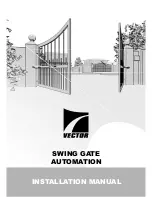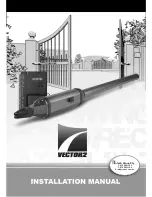
413
ENGLISH
Guide for the installer
Page
4.6.2. a
djusting
the
closing
mechanical
tRavel
stop
Set the operator for manual operation, see paragraph 5
Manually move the leaf in closing position.
Loosen the fastening screw, Fig. 19 ref.
a
. Do not remove the
screw.
Move the stop near the fitting as shown in Fig. 20.
The mechanical stop works coupled to a toothed sector, Fig.
19 ref.
b
. If there are any troubles during the movement,
make sure that the coupling is free. DO NOT FORCE.
Re-tighten the securing screw, checking correct coupling to
the toothed sector.
3.7. Limit switches
The “
LS
” models are equipped with opening and closing limit
switches. Therefore they require the use of a control board able to
control these inputs.
The limit switches are triggered for the first and the last 30 mm
of the travel. Therefore the operator should use the whole
available travel during the opening phase. Shorter travels
can limit or completely cancel the limit switch adjustment
range.
3.7.1. W
iRing
the
limit
sWitches
The limit switches are wired in the same terminal board where
the motor wiring has been carried out. Wire the limit switches as
follows:
Open the second pre-drilled hole in the cover, Fig. 21.
Fit the supplied cable gland, Fig. 21
Insert the cable and connect to the terminals of the colors
specified in the table below with reference to Figure 22.
Pos.
Colour
Decription
a
Blue
Common cable
b
Brown
Closing limit switch (FCC)
c
Black
Opening limit switch (FCA)
Close the cover with the four supplied screws.
For the limit switch connection use the cable for the exter-
nal movable laying with wires having a cross section of 0.5
mm
2
.
3.7.2. a
djusting
the
limit
sWitches
The limit switch adjustment is carried out as follows:
Remove the two plugs which cover the lower securing screws,
Fig. 23 ref.
a
. To facilitate this operation, a slot is provided for
inserting a screwdriver.
Unscrew both lower screws of the front cap and remove the
cover, Fig. 23.
Loosen the fastening screws of the limit switch to adjust, Fig.
24 ref.
a
.
Move the limit switch to the desired position and lock the
screws.
Perform a pair of test cycles to check the correct position of
the limit switch. If the adjustment of the limit switch needs to be
carried out again, repeat the operation starting from point 3.
Position again the cover by sliding it on the lower casting and
make sure that it reaches the stop, Fig. 25.
Screw both lower screws, Fig. 25.
Re-position the two front plugs.
3.8. Start-up
Cut power before any job on the system or on the operator.
Carefully observe points 10, 11, 12, 13 and 14 of the SAFETY GE-
NERAL RULES.
With reference to the indications in Fig.3, set the ducts and carry
out the electrical connections of the control board and of the
chosen accessories.
Always separate power cables from control and safety cables
(push button, receiver, photocells, etc.). To avoid any electrical
noise whatever in the unit, use separate sheaths.
Power up the system and check the LED condition as shown
in the table of the control board instructions.
Program the control board according to the needs by following
the given instructions.
1.
2.
3.
4.
5.
1.
2.
3.
4.
1.
2.
3.
4.
5.
6.
7.
8.
1.
2.
4. TESTING THE AUTOMATED SYSTEM
Carefully check operating efficiency of the automated system
and of all accessories connected to it, paying special attention
to the safety devices.
Hand the “User’s Guide” to the final user together with the Main-
tenance sheet.
Explain correct operation and use of the automated system to
the user.
Indicate the potentially dangerous areas of the automated
system to the user.
5. MANUAL OPERATION
If the automated system needs to be moved manually due to a
power lack or to an operator malfunction, proceed as follows:
Cut power by means of the safety circuit breaker (even in the
event of a power lack).
Slide the protective cap, Fig. 26/1.
Insert the key and turn it 90°, Fig. 26/2.
To release the operator turn 180° the control lever to the direc-
tion indicated by the arrow on the release system, Fig. 26/3.
Open and close the leaf manually.
To hold the operator in manual operation the release device
should be left in its current positions and the system should
be without power.
5.1. Restoring normal operation
To restore normal operating conditions, proceed as follows:
To prevent an involuntary pulse from activating the automated
system, make sure the system is not powered up using
the differential switch, before restoring normal operation
mode.
Turn the release system 180° in the opposite direction of the
arrow.
Turn 90° the release key and remove it.
Close the protection cover.
Power up the system and perform some movements in order
to check the correct restoring of every function of the auto-
mated system.
6. MAINTENANCE
To ensure a correct operation and a constant safety level over time
perform, every six months, a general check of the system paying
special attention to the safety devices. The booklet “Instructions
for use” contains a form for the registration of the maintenance
operations.
Every maintenance job or inspection performed by the
operator must only occur after having cut power to the
system.
7. REPAIRS
The user must not attempt any repair or job and must only and
exclusively contact qualified FAAC personnel or FAAC service
centres.
8. AVAILABLE ACCESSORIES
Refer to catalogue for available accessories.
9. SPECIAL APPLICATIONS
There is no special application other than the described use.
•
•
•
•
1.
2.
3.
4.
5.
1.
2.
3.
4.
Summary of Contents for 413 Series
Page 1: ...413...
Page 7: ...413 Immagini Images Images Im genes Bilder Afbeeldingen Pag Fig 1 Fig 2...
Page 13: ...413 Note Notes Note Notas Anmerkung Opmerkingen Page 10...
Page 14: ...413 Note Notes Note Notas Anmerkung Opmerkingen Page 11...
Page 18: ...413 Note Notes Note Notas Anmerkung Opmerkingen Page 30...
Page 19: ...413 Note Notes Note Notas Anmerkung Opmerkingen Page 31...
Page 20: ...413 Note Notes Note Notas Anmerkung Opmerkingen Page 32...







































